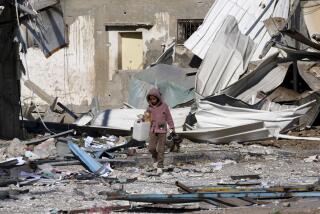Bypassing Oil Dearth, U.S. Finds Funds for Iraq
BAGHDAD -- The United States is opening the money spigot in Iraq, boosting the flow of funds through emergency outlays instead of waiting for oil exports to begin reviving the economy.
From an initial trickle, the revenue stream has increased to at least $10 million a day, the equivalent of about 40 cents a day for every Iraqi. The money is being pumped into the country through three principal arteries -- paychecks for civil servants, grain purchases from farmers and temporary jobs for the unemployed.
More tonic is on the way. Iraq’s civilian administrator, L. Paul Bremer III, announced plans Tuesday to create a $100-million construction fund to increase the pace of rebuilding and provide work.
Much of the money is being drawn from a $4-billion stash of frozen assets and confiscated loot once belonging to ousted President Saddam Hussein and his cronies. The remainder is coming from international donors, the U.N. “oil-for-food” program and U.S. taxpayers, who are covering the cost of keeping military forces in Iraq and launching the initial round of reconstruction work, officials said.
The goal is to put money in the hands of as many Iraqis as possible in hopes they will spend their way out of a postwar slump that could deepen into depression if the country waits for oil exports to provide an economic boost.
Peter McPherson, the Treasury Department’s top official in the country, said Iraq presents challenges unlike those encountered in Poland and other former state-run economies where the international community prescribed a harsh regimen of fiscal austerity to wring out inefficiencies and inflation.
“When you think about shock treatment, Polish-style, you worry about the massive unemployment that might bring,” McPherson said. “But here, they’ve already got massive unemployment. They’ve already had the shock treatment. So it’s a different puzzle than perhaps the world has seen.”
So far, the Bush administration has managed to step up the flow of funds without igniting public indignation in the United States, where members of Congress are seeking assurances that the cost to American taxpayers will be limited. But patience could wear thin if other resources run dry or the oil money is slow in coming, which some experts say increasingly looks to be the case.
Before the war, Iraq’s wells were pumping more than 2.5 million barrels a day, but production was shut down during the initial days of the conflict. The Iraqi Oil Ministry said it produced about 700,000 barrels Monday and predicted that output would be restored to prewar levels by the middle of next year. U.S. officials are counting on production averaging 2 million barrels a day in 2004.
Iraqi officials have scaled back their production estimates several times already. But some independent oil experts say the current projections remain over- optimistic.
“I think Iraq’s production profile is going to be a little flatter than that,” said oil analyst Raad Alkadiri at PFC Energy, a Washington consulting firm, after spending a week in Iraq. “In the longer term, there could be a problem because they were counting on oil revenues to fund the reconstruction.”
For the time being, much of the emergency spending is being bankrolled by the ghosts of the previous regime. The slush fund being drawn down by the governing authorities consists of about $1.7 billion in Iraqi government assets frozen in the United States, $1.2 billion seized in other countries, $900 million in hidden cash discovered by U.S. forces in Iraq and $350 million in currency and gold found in the vaults of Iraq’s central bank.
Other sources of funds for Iraq’s reconstruction include $1 billion from the oil-for-food program, $2 billion pledged by other countries and $2.5 billion earmarked for relief and reconstruction in an emergency war appropriation approved by Congress.
The biggest transfer of funds is the payment of salaries and pensions to past and present government employees.
About 1.5 million civil servants and retirees are to receive nearly $560 million over a period of three months, all of it coming from the frozen assets of Hussein’s regime.
The ruling authority is tapping Hussein’s frozen accounts to buy this year’s wheat and barley harvest from thousands of farmers in a country where about 30% of the economy is tied to agriculture. The crop payments are expected to total $150 million over six weeks.
A third source of stimulus is being provided by hundreds of millions of dollars in reconstruction contracts, some of which are creating jobs, albeit temporary ones, for Iraqis who otherwise would contribute to an unemployment rate estimated at anywhere from 30% to 50%.
The $100-million construction fund announced by Bremer on Tuesday designates $45 million for urgent construction projects, $20 million to refurbish government ministries damaged by bombs and looting and $35 million to complete public works projects launched by Hussein’s regime. “In all of these cases, work will be done by Iraqi construction companies, creating jobs for Iraqis,” Bremer said. “We are trying hard to get the economy going by getting money into people’s hands.”
Former World Bank chief economist and Nobel laureate Joseph Stiglitz said the outlays would raise living standards in Iraq. But he cautioned that they would lead to long-term economic growth only if they contributed to the creation of lasting private-sector employment.
“You want them to start producing and not just consuming,” Stiglitz said in a telephone interview. “If the money is spent to import a refrigerator, it doesn’t do the Iraqi economy any good. Imported refrigerators do not translate into jobs.”
More to Read
Sign up for Essential California
The most important California stories and recommendations in your inbox every morning.
You may occasionally receive promotional content from the Los Angeles Times.










